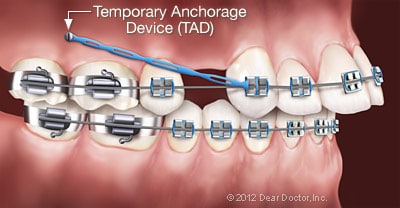Temporary Anchorage Devices, or TADs, are small titanium anchors used for the purpose of providing orthodontic anchorage, and are removed at the completion of treatment. They may be used in certain cases to help fix more complex orthodontic problems and achieve quicker tooth movement with more efficiency and comfort.
TADs may be used in addition to braces or as an alternative to headgear. In conventional orthodontic treatment, there are often unwanted tooth movements that occur when certain movements are attempted. TAD’s allow us to move only the teeth that we want to and thus help to not only shorten treatment but also to accomplish goals that are not achievable with regular braces.
In the past, the use of bone anchorage was limited due to expense and complexity of placement. However, newer Temporary Anchorage Devices are safer and less expensive.
 TADs can:
TADs can:
- Stabilize a tooth being used as an anchor
- Eliminate the need to use a tooth as an anchor
- Provide an anchorage point where tooth anchorage is not normally available
Orthodontics with TADs can:
- Reduce orthodontic treatment time by one third
- Eliminate the need for a headgear
- Provide a more ideal finish
- Allow for significant skeletal changes during growth modification procedures
- Allow limited tooth movement in preparation for a bridge, crown or implant without braces
- Close most open bites without surgery
- Eliminate the need for rubber bands
Dr. MacGinnis is among the first orthodontists in the Orange County area to use TADs extensively. Unlike most orthodontists, Dr. MacGinnis places the TAD himself, there is no need to refer patients to other specialists for the procedure.
A TAD is an implant that is fixed to bone for the purpose of providing an absolute anchorage point for movement of teeth. TADs are removed and discarded at the end of orthodontic treatment.
A TAD is capable of:
- Replacing a headgear
- Closing an open bite
- Opening a deep bite
- Correcting a Class II
- Correcting a Class III
- Correcting an occlusion asymmetry
- Uprighting a tipped molar in preparation for restorative without full braces
- Intruding or extruding teeth for restorative procedures usually without full braces
- Correcting a single tooth crossbite without full braces
- Orthognathic surgery can be simplified to one jaw
- TADs are good fixation points to manage post-orthognathic surgery patients
TADs do not work for every patient but in many cases, they shorten treatment and improve our final result. Please contact our office for more information about this treatment.

 TADs can:
TADs can:



